
Resurrection of a King
Part III: Early History of the King's Special
The new body was a knock-out! The styling was virtually identical to the early 'Morton and Brett' bodies created for the Indy 500, with a long, narrow hood, slender body, and boat-tailed rear end. Yet, this was a home-built body, one that varied by an inch or so in actual dimensions from the professionally produced Indy cars, but resembled them in almost every other aspect.
The cockpit, only 19" wide (TJ, Sept. 25, 1957) was carefully trimmed in a rolled and wired edge. Pictures of the car at this time show that upholstery covered the single seat and folded over the rear edges of the passenger compartment to provide an element of safety. Like its predecessor, the car still featured a wind deflector in front of the steering wheel. The radiator and shell were most likely modified from existing used car components, but the hood was unique, having large scoops on the lower panels where one might expect louvers. Careful detail went into providing trim that covered the frame area around the radiator, as well as delicate "tail fins" on the rear. The entire body was sheet steel over an angle iron framework, the latter being gas-welded, as electric welding was not available in most small shops in the '20's. As much as this body seemed so far removed from the one that crashed in 1929, if one is to compare the pictures of the two cars, the chassis and exhaust header are identical. The frame may have been replaced, perhaps axles and other "T" parts too, but the result was to have the same basic chassis that they had before. The wire wheels, too, may have been replaced after the accident, but the same style was used on the new version. The car and chassis were painted white, which was totally impractical, but it certainly made it distinctive. The car's appearance may not have enhanced performance, but it likely buoyed the spirits of the owners and driver.
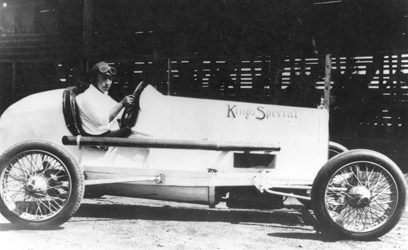
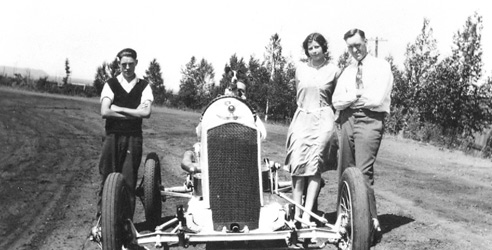
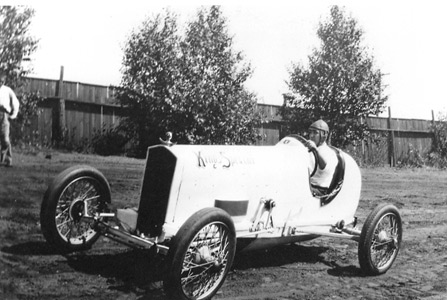
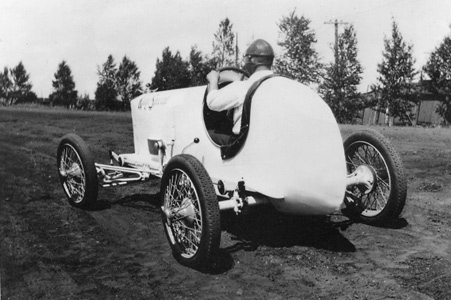
The colour of the car was even more enhanced by the driver's behavior: Frank Colosimo "would begin a meet with a spotless starched white shirt" (TJ, Sept. 25, 1957) and expected to stay in the lead so that it, as well as his car, would still be white at the end of the race. Another antic that inspired his followers was to drive past the grandstand flashing $10 bills in attempts to have fans wager against him. Both car and driver did very well with the newest version of the "speed wagon".
A clipping from the News Chronicle (July 2, 1931) states:
Frank Colosimo is First Place Winner at Murillo . . . Frank Colosimo, veteran dirt track driver romped off with first honors in the class A, eliminating seven of the fastest cars at the Lakehead to take first money. Colosimo drove "King's Special Ford. Drivers, toward the middle of the afternoon, were caked from head to foot with black mud. Colosimo, nothing loath, disappeared for a short time and triumphantly returned clad in a shining new shirt. The shirt, incidentally, remained comparatively clean for the rest of the afternoon, for Frank in his remaining races was always out in front of the flying mud.
The races in August were equally as good for the newly renovated car and colourful driver. As the same paper (NC, Aug. 3, 1931), first introduced the race:
Frank Colosimo, at the wheel of Arthur King's Ford Special which holds practically every two-mile dirt track record in the district with which he expects to place Monday at Murillo.
and then followed up the following day:
The Feature Race The feature race between Davidson and Colosimo for a side bet of $100 and the racing crown of the Lakehead became a fiasco once Frank forged into the lead, but the start came very near being the finish for both racers. Rounding the treacherous North turn, both cars locked wheels, and Colosimo, who was on the outside, was forced almost into the ditch. Six spokes were torn from his left rear wheel, but he went on to pass Davidson on the straightaway and kept far enough ahead for the rest of the race never to be threatened, while Davidson, railing in the dust of King's Special, became so blinded by the cloud of powdered dirt that he swung his car into the field at the center of the track . . . . . This fatal swerve into the bush undoubtedly cost him the race.
The successes were not limited to the Lakehead track alone. By rail, and perhaps ship, the car was taken to distant cities to compete in top notch racing. As Ernie Boffa (a veteran racer introduced earlier in this story) exclaimed: "Another guy, King, built a Liberty Ford, the type used at Indianapolis, and I drove it for him on the tracks at Superior, Winnipeg, and elsewhere." The King's Special was well known from at least Wisconsin to Manitoba.
Anyone reading this and old enough to have heard about the Great Depression must be wondering how these races carried on when the economy had tanked. The Stock Market crashed in 1929, at the same time the King's Special did. Yet the races were continued at least as late as 1934, and the race car was rebuilt over the winter of '29 to be on the track for the 1930 racing season. Attendance, though, dropped. From 4000, the numbers fell to 1000 for the race described in the above paragraph. By 1934, according to an unidentified newspaper clipping, things had worsened:
Although perfect autumn weather prevailed, only a meager crowd attended.
The same article describes, perhaps, the last official race of the King's Special:
Frank Colosimo, 'piloting Ernie King's dinky Ford' had a double win in auto races at the Fair Grounds. He defeated Eddie Cusson in Alex MacLeod's 'Red Devil' as well as MacLeod in the 'Dreadnaught,' then went on to win the free-for-all race, which also included Pat Bryan driving a Chalmers.
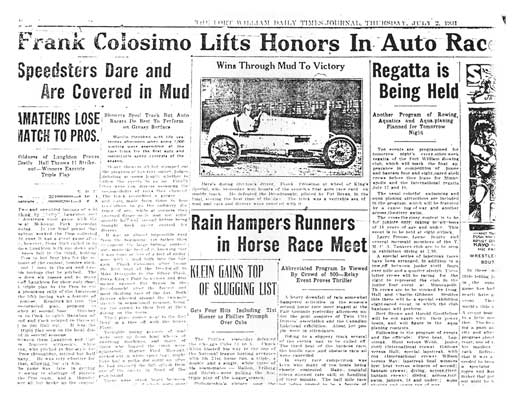
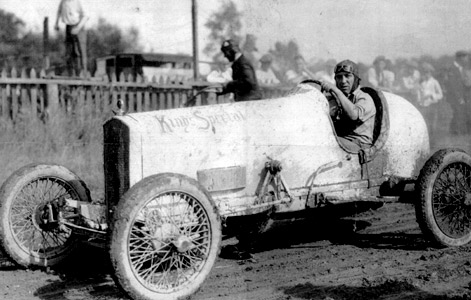

With the Depression, The Dark Ages seemed to have settled in as far as organized racing was concerned, but further research may show otherwise. Five decades would go by before someone, an outsider, who lived more than a thousand miles away, would take up the challenge of finding whatever became of the legendary "King".